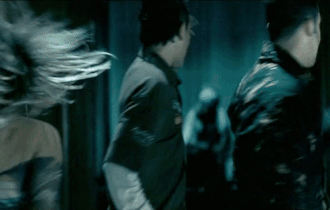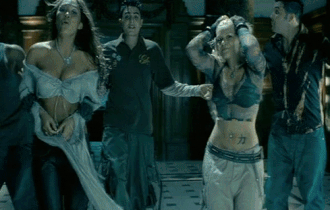Released: 12th August 2002
Writers: David Eriksen / Kelly Levesque
Peak position: #6
Chart run: 6-26-37-56-X-X-62-48-75
With Lovin’ Is Easy, Hear’Say tried to weather a storm of intense media scrutiny. But amid the resurgence of their Popstars rivals, a further evolution of the TV talent show format and a controversial line-up change, the song itself became the least important aspect of this single.

The journey to Lovin’ Is Easy was fraught with challenges. The first major hurdle came eight months earlier when Kym Marsh departed Hear’Say. Having been installed as the de facto lead singer, her absence would profoundly affect the DNA of the group. The audition process to find a replacement was planned to mirror the original Popstars format, but it quickly descended into chaos when Johnny Shentall (the fiancé-now-husband of Lisa Scott-Lee) was picked. As a backing dancer and former member of Boom!, it was outrageous that someone who appeared to be very well qualified for the job should be picked to do it. Before he’d even uttered a word in the recording studio, Hear’Say had to release a press statement denying that his appointment was a “fix” (a fix of what, exactly?) and the TV show became an exercise in defensive damage limitation. So, that wasn’t the greatest start for the new line-up.

Two other significant things happened in 2002 that affected Hear’Say both directly and indirectly, neither of which made the task ahead of them any easier. When Will Young emerged as the inaugural winner of Pop Idol at the turn of the year, his underdog triumph over Gareth Gates turned TV talent shows into more than just a window into the music industry. The public now had the power to influence and subvert the narrative, and in little more than 12 months, the cutting-edge concept of Popstars had become outdated. The predetermined formation of Hear’Say suddenly rendered them a burden that was foisted upon the public.

Alongside that evolution, the newly-rebranded Liberty X overcame their “Flopstars” label to stage a comeback with the critical and commercial smash hit Just A Little. The public might not have been able to control the formation of either group, but they could certainly choose whose product they purchased. Of course, there was no rational reason that both acts should not enjoy success. But that is the nature of the TV talent show beast, and why it has frequently been so problematic in chart terms. There is no room for centrism; there has to be a winner and a loser to make the format commercially viable and drive audiences towards the phone lines.

With so much context surrounding the release of Lovin’ Is Easy, it’s not hard to see why the song itself got lost in the middle of the commentary and speculation. Not that it was ever going to be judged on its own merit; by this point, Hear’Say could do no right. That the single chose to pursue a more R&B-leaning direction – and thus drew unflattering comparisons to Liberty X – was a moot point. For had they stuck to a pop-orientated sound, the criticism instead would have been that they were peddling a cheesy, dated song. Whatever they did with this single, Hear’Say were set up to fail; the critics had their knives out and were baying for blood, with a damning judgement prepared for every possible response that the group could give to the obstacles in front of them.

All of which makes it a pleasant surprise that Lovin’ Is Easy turned out as well as it did. Yes, there’s a certain degree of bandwagon-jumping, but Hear’Say were not the only pop act to incorporate elements of R&B around this time. Indeed, take their previous release Everybody out of the equation, and this track feels like a very logical evolution of the group’s sound. And that’s, of course, presuming that it was possible to make a fair assessment of their ‘sound’ after just four singles. The production isn’t remotely hung up on showcasing Hear’Say as singers (been there, done that). Instead, it focuses on layering Lovin’ Is Easy with ad-libs, backing vocals, scratchy riffs and “Ba-ba-ba” hooks to create a funky track that is continually shifting and changing shape. At one point the editing is so enthusiastic that it bluntly chops the line: “Holding you close and feeling your body”, creating what sounds like a glitch that slipped through the mastering.

Although the boys now outnumbered them, the gender shift in the lyrics puts the girls firmly in the driving seat. Myleene Klass and Suzanne Shaw go full-on pop vixen here: “Touching your skin, I want to have you to myself boy, I only want you-ooh-ooh”. There’s little attempt to frame the narrative from a co-ed perspective, other than the very occasional retort (“Want you too yeah”), which feels more coincidental than anything else. For the most part, the male contingent of Hear’Say is left to add little more than a lower harmony to the chorus and a few backing vocals here and there. Noel Sullivan does – at least – manage to score a few ad-libs towards the end. The unequal division of work may have perturbed some, but Lovin’ Is Easy is arranged in a way that works best for the song. A male lead vocal isn’t needed here, but that doesn’t mean Noel, Danny and Johnny’s collective contribution is superfluous. Indeed, they are pivotal in giving the track slightly unpredictable energy as it fires in all directions to punctuate each line with increasing tenacity as the song progresses.

Thankfully, with so much going on, Lovin’ Is Easy doesn’t forget to pack a killer chorus. It’s not exactly a subtle effort but equally doesn’t jump out quite so overtly as Hear’Say’s earlier material. However, it’ll soon creep its way into your head: “I want you to know just how I feel, that the love inside is truly real, ’cause baby, lovin’ is easy”. The chorus quite literally smashes its way into the song (someone was a big fan of that sound effect because it’s applied liberally throughout), before playing out with a marching beat that is paced with military-like precision. It’s a bit of a grower, but soon cements itself as one of Hear’Say’s best and most enduring endeavours. Lovin’ Is Easy offers far more than a quick hit, but of course, there was no chance that it would ever be allowed to flourish, such was the resistance shown towards it.

The music video for Lovin’ Is Easy is difficult to appraise. Certainly, this does not seem like the moment to kick Hear’Say when they were down, but there is nonetheless something fundamentally flawed with the end product. In terms of what it does right, well, it pushes the group’s new direction to the fore, with street dance styling that creates an altogether edgier (if at times highly impractical) look. Furthermore, the choreography – including an achingly of-its-time dance breakdown – is impressive by any standard, but particularly considering where Hear’Say had started the previous year. Taking the video at face value, it’s perfectly suited to Lovin’ Is Easy. But therein lies the problem; dropping the group into a mansion to perform the track is, in itself, not a flawed concept, but the execution completely rinses them of their identity. This single needed to establish a new status quo and draw a line under everything that had happened leading up to it. But instead, it all feels strangely hollow, like an empty shell of a pop video. The heart and soul that any pop act needs to survive is strikingly absent as if the realisation of the impossible challenge ahead had already set in and the group was merely going through the motions. It seems harsh, but we challenge anyone to sit through Lovin’ Is Easy (if you can find it; the video is absent from every major platform) and reach a different conclusion. The atmosphere on set may well have been electric, but if it was, the visuals don’t convey it very well at all.

Ironically, Johnny Shentall’s involvement with Lovin’ Is Easy winds up being one of the least noteworthy things about the song, because his presence is barely noticeable. Perhaps that was the intention following the furore about his joining Hear’Say in the first place, but it seems like the best way to move past the “fix” accusations would have been to show outright why he deserved his position within the group. There’s no denying that he elevates the dance sequences in the music video; his experience in that domain is clear to see. But besides that, the whole setup feels awkward and void of the dynamic that had been forming before Kym Marsh’s departure.

With the odds stacked so highly against them, the fact that Hear’Say managed to take Lovin’ Is Easy to #6 was a considerable achievement, not that it was regarded as such (quelle surprise). In the immediate aftermath, the group continued recording for their third album and a rumoured follow-up single called If You Wanna Roll With Me was planned. But it was not to be; regardless of what else was – or wasn’t – happening behind-the-scenes, everyone could see that there wasn’t a way forward for Hear’Say after Lovin’ Is Easy. The public was done with them, and that opinion was no longer based on the quality of their material. If it ever had been at all. A few months passed, and the group announced their split.

But what emerged in the aftermath was the tale of an unpleasant phenomenon that would become increasingly prevalent. The public, not content with merely turning their back on the group, had actively tried to take back the golden opportunity Hear’Say had been given. As they trekked up and down the country promoting Lovin’ Is Easy, they were subjected to a torrent of abuse and threats of violence (which were then publicised as fabrications designed to elicit sympathy). The group’s commercial fortunes may have dimmed, but it was not that alone which led to their split. It was the behaviour of the public – the very people who had given the group their success in the first place – that was the final straw. Hear’Say spoke openly about how difficult the experience was. Their crime, lest we forget, was winning a TV talent show. That’s it. At the very least you’d hope people learned something from the openness with which the group recounted an ugly few months. Alas…

The cruel irony with Lovin’ Is Easy is that the song was never the focus here. It’s come to represent something altogether rather undesirable, which is a real shame because it’s far better than anyone was willing to admit.



